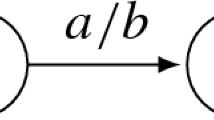Abstract
Automaton groups are a class of self-similar groups generated by invertible finite-state transducers [11]. Extending the results of Nekrashevych and Sidki [12], we describe a useful embedding of abelian automaton groups into a corresponding algebraic number field, and give a polynomial time algorithm to compute this embedding. We apply this technique to study iteration of transductions in abelian automaton groups. Specifically, properties of this number field lead to a polynomial-time algorithm for deciding when the orbits of a transduction are a rational relation. These algorithms were implemented in the SageMath computer algebra system and are available online [2].
Access this chapter
Tax calculation will be finalised at checkout
Purchases are for personal use only
Similar content being viewed by others
References
Bartholdi, L.: Book review: combinatorial algebra: syntax and semantics. Bull. AMS 54(4), 681–686 (2017)
Becker, T.: Embeddings and orbits of abelian automaton groups (2018). https://github.com/tim-becker/thesis-code
Bondarenko, I., et al.: Classification of groups generated by 3-state automata over a 2-letter alphabet. Algebra Discrete Math. 1, April 2008
Brough, M., Khoussainov, B., Nelson, P.: Sequential automatic algebras. In: Beckmann, A., Dimitracopoulos, C., Löwe, B. (eds.) CiE 2008. LNCS, vol. 5028, pp. 84–93. Springer, Heidelberg (2008). https://doi.org/10.1007/978-3-540-69407-6_9
Faugère, J.C., El Din, M.S., Spaenlehauer, P.J.: Gröbner bases of bihomogeneous ideals generated by polynomials of bidegree (1, 1): algorithms and complexity. J. Symbolic Comput. 46(4), 406–437 (2011)
Grigorchuk, R.I., Nekrashevich, V.V., Sushchanskii, V.I.: Automata, dynamical systems and groups. Proc. Steklov Inst. Math. 231, 128–203 (2000)
Hungerford, T.W.: Algebra. Springer, New York (1974). https://doi.org/10.1007/978-1-4612-6101-8
Ireland, K., Rosen, M., Rosen, M.: A Classical Introduction to Modern Number Theory. Graduate Texts in Mathematics. Springer, New York (1990). https://doi.org/10.1007/978-1-4757-2103-4
Latimer, C.G., MacDuffee, C.C.: A correspondence between classes of ideals and classes of matrices. Ann. Math. 34(2), 313–316 (1933). http://www.jstor.org/stable/1968204
Lazard, D.: Solving zero-dimensional algebraic systems. J. Symbolic Comput. 13(2), 117–131 (1992). https://doi.org/10.1016/S0747-7171(08)80086-7. http://www.sciencedirect.com/science/article/pii/S0747717108800867
Nekrashevych, V.: Self-similar groups. Mathematical Surveys and Monographs. American Mathematical Society, Providence (2014)
Nekrashevych, V., Sidki, S.: Automorphisms of the binary tree: state-closed subgroups and dynamics of 1/2-endomorphisms. London Math. Soc. Lect. Note Ser. 311, 375–404 (2004)
Okano, T.: Invertible binary transducers and automorphisms of the binary tree. Master’s thesis, Carnegie Mellon University (2015)
Raney, G.N.: Sequential functions. J. ACM (JACM) 5(2), 177–180 (1958)
Robinson, R.M.: Conjugate algebraic integers on a circle. Mathematische Zeitschrift 110(1), 41–51 (1969). https://doi.org/10.1007/BF01114639
Stein, W.: Algebraic Number Theory, a Computational Approach. Harvard, Massachusetts (2012)
Sutner, K.: Abelian invertible automata. In: Adamatzky, A. (ed.) Reversibility and Universality. ECC, vol. 30, pp. 37–59. Springer, Cham (2018). https://doi.org/10.1007/978-3-319-73216-9_3
Sutner, K., Lewi, K.: Iterating inverse binary transducers. J. Automata, Lang. Comb. 17(2–4), 293–313 (2012)
Acknowlegements
The authors would like to thank Eric Bach for his helpful feedback on a draft of this paper. We also thank Evan Bergeron and Chris Grossack for many helpful conversations on the results presented.
Author information
Authors and Affiliations
Corresponding author
Editor information
Editors and Affiliations
Rights and permissions
Copyright information
© 2019 Springer Nature Switzerland AG
About this paper
Cite this paper
Becker, T., Sutner, K. (2019). Orbits of Abelian Automaton Groups. In: Martín-Vide, C., Okhotin, A., Shapira, D. (eds) Language and Automata Theory and Applications. LATA 2019. Lecture Notes in Computer Science(), vol 11417. Springer, Cham. https://doi.org/10.1007/978-3-030-13435-8_5
Download citation
DOI: https://doi.org/10.1007/978-3-030-13435-8_5
Published:
Publisher Name: Springer, Cham
Print ISBN: 978-3-030-13434-1
Online ISBN: 978-3-030-13435-8
eBook Packages: Computer ScienceComputer Science (R0)




